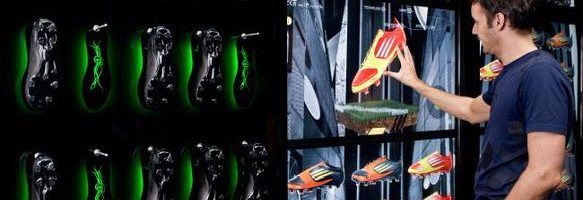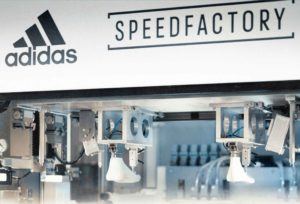How digitalization is supporting Adidas expand the reach of Fast Fashion

Adidas strategy to grow is “to be the first fast sports company in the sporting goods industry”. The company is digitalizing its entire supply chain – from design to distribution – to achieve this goal. Can Adidas be successful in this endeavor? What does it take to become the “Zara of the sport industry”?
How can Adidas achieve sustainable growth in such competitive market as the sport sector? For many years, Adidas bet in its R&D capabilities and brand strength. However, after declining sales in 2013 and 2014, it was time for a change: the company shifted from product to a customer-centric strategy, investing in product customization[1]. Adidas is trying to adapt the wide-known Zara’s strategy to the sport industry. However, this requires fundamentally transforming the company’s supply chain with two purposes: (1) drastically shorten the time-to-market – today, it takes up to 18 months to deliver a sneaker[2] from design to shelf, and (2) increase flexibility to make the production of customized – and usually smaller – batches economic feasible.
Supply chain digitalization is a wide-spread trend and is one of the main enablers for Adidas to “transform” into fast fashion. Potential solutions include: data-driven design, IT integration with suppliers and retailers, real-time planning, automation of manufacturing facilities, among others. It is also important to highlight that shortening the supply chain may also imply in physically bringing together all the elements of the chain, which directly ties to the isolationism trend. Adidas outsources almost 100% of its production to independent third-party suppliers, primarily (roughly 80%) located in Asia. Bringing the chain closer to the customer would fundamentally change the production footprint: in 2016, Asia represented 36% of Adidas’ sales[3].
In the short term, Adidas has been testing digitalization concepts in each of the steps of its supply chain: design, manufacturing and distribution. Scaling the digitalization up is certainly the company’s long-term goal. However, it still seems unclear how it plans to achieve this.
On design, Adidas is investing in data-analytics to decrease the design time while increasing accuracy. In 2015, it acquired Runtastic, a mobile fitness startup, getting access to data of 70 million users[4]. Also, the recently launched AM4 series has been developed based on athletes’ data and an open-source co-creation[5].

On manufacturing, Adidas is testing “Speedfactories”. The first plant, with a small capacity of 500,000 pairs of trainers a year, was built in Germany, while more than 90% of the company’s trainers’ production is mostly manual and located in Asia[3]. Adidas built its speedfactory with highly automated and flexible machines, wide use of 3D printing machines and near to the end customer[6]. While replenishing an existing design through Asia’s facilities may take two to three months, Adidas is targeting to decrease the time to less than a week[2].
On distribution, Adidas focused on omni-channel initiatives through its e-commerce and own-retail stores. The company is investing in technology, such as RFID, to allow online buyers tocheck stores inventory, purchase online and collect in store[3]. Also, in India, the company used tablets to give access for the stores’ customers to the full range of products in the e-commerce platform[7]. Through this, Adidas minimizes the occasions the consumer is not able to find the product. In Russia, the company also started the “Ship from Store” initiative, transforming points of sale in small distribution centers, reducing the distance to consumers and decreasing delivery time[8].
Adidas has clear rollout goals in the medium term. The company aims to increase the participation of low time-to-market products from 15% of sales in 2016 to 50% in 2020[3]. It also expects to increase own-retail stores sales from 40% in 2014 to 60% in 2020[9]. The main challenge for Adidas, however, is how to make such a significant shift from outsourcing to in-house manufacturing and increase direct-to-consumer distribution without disrupting operational and financial performances.
For manufacturing, Adidas should consider two business units: “fast fashion” and “traditional”. The latter would comprise standardized products with more predictable sales. These products’ production would be kept under the third-party suppliers in Asia while the new speedfactories would be located in markets with the highest demands for fast fashion. The “traditional” unit should also be used to minimize the risk of disengagement of the current suppliers for expecting the termination of contracts. Adidas could stimulate “peer pressure” to motivate the suppliers to improve service so to guarantee that they will be the ones chosen for the “traditional” production.
For distribution, relying most on own-retail stores may either be very capital intensive or decrease the overall number of points of sale, creating opportunities for competitors. Instead, Adidas can increase control of sales by targeting the own-retail stores to its key customer markets and making partnerships with large retailers in other markets to implement a more tailored purchase experience. One potential solution, for example, is to invest in stores-within-a-store.
The next years will represent a major transformation for Adidas. In such context, one may ask: can Adidas sustain “fast fashion” as a competitive advantage? Is the company able to react to competitors trying to follow the same approach?
(Word count: 800)
Sources:
[1] F. Piller, E. Lindgens, and F. Steiner, “Mass Customization at Adidas: Three Strategic Capabilites to Implement Mass Customization” (Jan. 29, 2012)
[2] The Economist, “Adidas’ high-tech factory brings production back to Germany,” (Jan. 14, 2017)
[3] Adidas Annual Report (2016)
[4] Reuters, “Adidas buys fitness tracking app maker Runtastic,” (Aug. 5, 2015)
[5] Adidas’ Speedfactory website, https://www.adidas.com/us/speedfactory
[6] Bloomberg, “Adidas brings the fast shoe revolution one step closer” (Oct. 5, 2017)
[7] Economic Times Retail, “Adidas bets big on omni-channel play in India” (Se
p. 06, 2015)
[8] Supply Chain Digital, “Supply Chain 4.0: Adidas and Amazon re-write the rules on supply chain management
[9] Fortune, “Adidas aiming for faster sales and profit growth from 2016” (Mar. 26, 2015)



Joana, thank you for this very interesting paper.
I think that given the wider industry trends, Adidas has no choice, but to move to fast fashion. If it does not do so, it risks lagging behind its competitors (Nike, Under Armor, etc.) who are also rapidly transforming their supply chain to quickly respond to consumer demands. By manufacturing more of its products closer to the end customer – i.e. in Germany and the US – Adidas seeks to make less product up front, and to quickly replenish items that are selling well.
Having said that, in order for this approach to be successful and sustainable, I believe that Adidas needs to also consider the impact of this strategy to the rest of its organizational model. It could very well be, that an organizational restructuring is required in order for this model to work. Specifically, the innovations that the company is implementing on the manufacturing, supply, and production side of its business have crucial implications for its sales and marketing divisions. If the marketing function is no longer responsible for forecasting demand, then what is its role and how should it interface with the rest of the organization? The lines between IT, sales, marketing and production are becoming less and less clear and these functions will need work in a much more integrated manner. The revamped way in which Adidas delivers products to market means that every link in the organization needs to have full visibility to the needs of the others. Supply and demand signals will need to be visible across the network and the ways that marketing, supply, manufacturing, and IT work together will need to also be adapted.
Joana,
Thank you for this great post. I feel as though your question as to whether or not Adidas can sustain “fast fashion” as a competitive advantage is a crucial one for the customer to consider. That being said, I believe that the implications of Adidas’ focus on digitizing their supply chain process so that shoes can go from a sketch book to store shelves as quickly as possible has even greater implications on their cost structure than it does around their ability to compete in the fast fashion space.
Although the speed from ideation to a product being on the shelf is certainly crucial, I don’t believe that the customer promise for Adidas to be timely with their designs is as great as the customer promise which companies like Zara make to their customers who want to see low cost fashion trends that are matched with what is seen at fashion shows and from high-end items. The greater value add to digitization for Adidas stems from being able to produce their shoes significantly cheaper as Nike is doing: “Nike investing in a company making electrical adhesion machines that can assemble the upper part of a shoe 20 times faster than a human worker can.” [1] This is a trend where Adidas can’t affords to lose out to their competitors and therefore they will need to focus on similar production capability improvements in order to remain competitive.
Unlike Zara, Adidas does not need to follow fashion trends in quite as timely of a matter. As long as they have a product which is differentiated from anything else that is in the market, they will be competitive. Therefore, their ability to manufacture certain parts of their shoe via machine rather than human labor allows them to “keep the latest trends and ideas in-house rather than sharing them with suppliers.” [2] This is compelling because there product needs to be differentiated from that of their competitors such as Nike.
[1] Bloomberg, “Adidas brings the fast shoe revolution one step closer” (Oct. 5, 2017)
[2] Bloomberg, “Adidas brings the fast shoe revolution one step closer” (Oct. 5, 2017)
Joana, thank you for sharing this article. I think you raise several poignant questions on how the sporting good industry will have to adapt. I also believe that Adidas has no option but to take on Zara’s “fast-fashion” model – and that doing so requires considerable investments in data analytics and technologies that can digitalize the company’s supply chain.
I particularly liked your point on how Adidas would benefit from moving production closer to the end-user through 3D printing technologies in speed factories. This would certainly allow the company to tap into customer demand for “customized” products. As the retail world has moved online by embracing e-commerce platforms, I would imagine that customers would one day be able to design their fully customized shoes online prior to completing the purchase. Given the proliferation of e-commerce, do you think that Adidas is realistic in wanting to increase own-retail stores sales from 40% in 2014 to 60% in 2020? As I see it, delivering a customized end product to the shopper requires significant reliance on e-commerce platforms and less dependence on physical retail stores.
Thanks again for sharing this article!
Thank you for this great article, Joana. I do think that Adidas must move toward ‘fashion brand’ to stay competitive in the market as key competitor, Nike already established strong image on sport fashion brand [1]. With Adidas’s operating model of outsourcing to third-party manufacturers, it is extremely difficult to significantly reduce lead time from design to shelf. Compared to the model adopt by Zara, in order to deliver new design collection to their stores quickly, the whole design to factory is being done in-house [2]. Their designers are working with pre-selected set of fabrics, although eliminating all the procurement lead time, limiting the innovation and creativity. Therefore, I think Adidas would face difficulties on various fronts in order to successfully sustain ‘fast-fashion’ unless it completely changes the operating model like you suggested.
[1] Sergran, Elizabeth. “How Nike became a fashion powerhouse.” The Fast Company. https://www.fastcompany.com/3068182/how-nike-became-a-fashion-powerhouse. Accessed December 1, 2017.
[2] O’Marah, Kevin. “Zara uses supply chain to win again.” Forbes. https://www.forbes.com/sites/kevinomarah/2016/03/09/zara-uses-supply-chain-to-win-again/#46e91a721256. Accessed December 1, 2017.